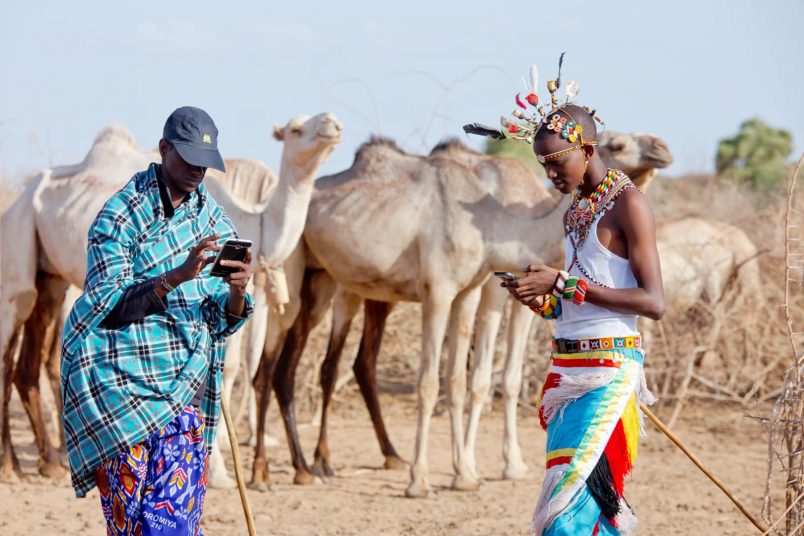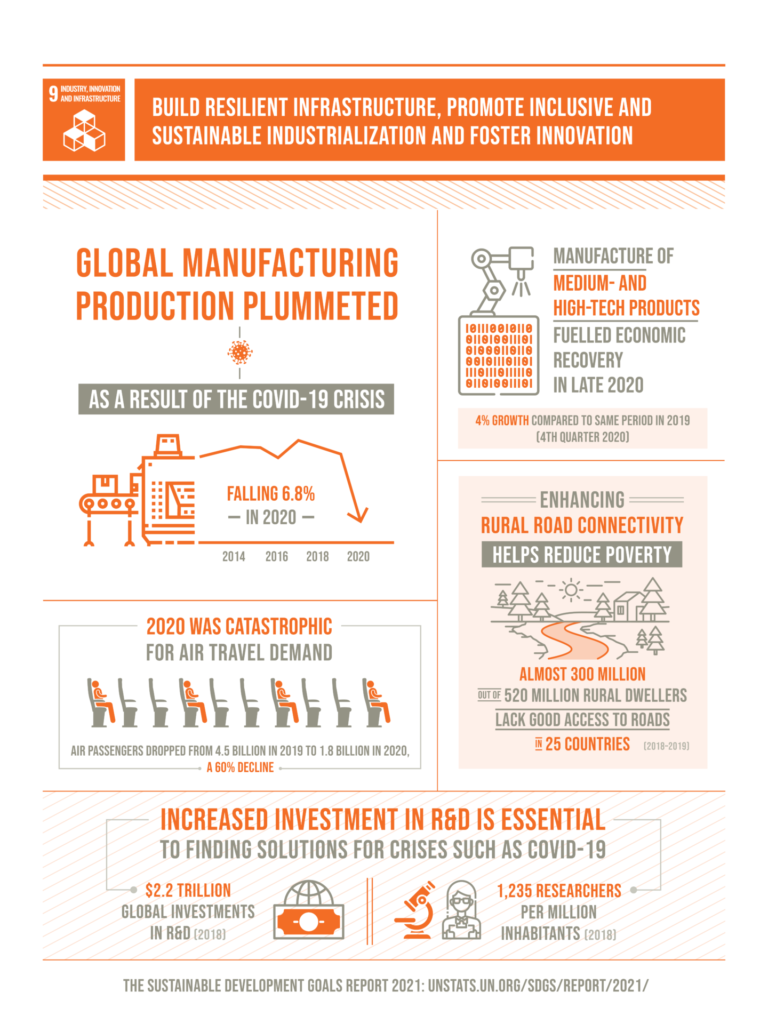Globally, Africa is home to the second-largest number of people but has the lowest number of Internet connections. As of the end of 2019, mobile internet adoption in the continent stood at a meager 26%, according to a GSMA report. This could soon change after SoftBank and Smart Africa Secretariat (Smart Africa) have entered into a Memorandum of Understanding (MoU) to develop solutions that enable affordable broadband across Africa.

Updated December 9. 2024 & December 9. 2023 (originally published December 9. 2021)

United Nations Global Goals for Sustainable Development
Goal 9 seeks to build resilient infrastructure, promote sustainable industrialization, and foster innovation.
Economic growth, social development, and climate action heavily depend on infrastructure investments, sustainable industrial development, and technological progress. In the face of a rapidly changing global economic landscape and increasing inequalities, sustained growth must include industrialization that makes opportunities accessible to all people and be supported by innovation and resilient infrastructure.
Even before the outbreak of the COVID-19 pandemic, global manufacturing—considered an engine of overall economic growth—had been steadily declining due to tariffs and trade tensions. The manufacturing decline caused by the pandemic has seriously impacted the global economy.
This is primarily due to high inflation, energy price shocks, persistent disruptions in the supply of raw materials and intermediate goods, and global economic deceleration.
While Least Developed Countries in Asia have made considerable progress, African LDCs must change the current trajectory and accelerate progress to attain the target by 2030. However, medium-high and high-technology industries demonstrated robust growth rates.
How much progress have we made?
As of 2022, 95 percent of the world’s population was within reach of a mobile broadband network, but some areas remain underserved. Investment in research and development globally—as well as financing for economic infrastructure in developing countries—has increased, and impressive progress has been made in mobile connectivity, with almost the entire world population (97 percent) living within reach of a mobile cellular signal.
COVID-19 response
Information and communication technologies have been on the frontlines of the COVID-19 response. The crisis has accelerated the digitalization of many businesses and services, including teleworking and video conferencing systems in and out of the workplace, as well as access to healthcare, education, and essential goods and services.
As the pandemic reshapes the way we work, keep in touch, go to school, and shop for essentials, it has never been more important to bridge the digital divide for the 3.6 billion people who remain offline, unable to access online education, employment, or critical health and sanitation advice. The 2020 Financing for Sustainable Development Report provides policy options to harness the potential of digital technologies.
Once the acute phase of the COVID-19 crisis is over, governments will need investments in infrastructure more than ever to accelerate economic recovery, create jobs, reduce poverty, and stimulate productive investment.
The World Bank estimates that developing countries need to invest around 4.5 percent of GDP to achieve the Sustainable Development Goals and limit global warming to no more than 2 degrees Celsius.
Facts and Figures
- In 2018, 96 percent of the world’s population lived within reach of a mobile-cellular signal, and 90 per cent of people could access the Internet through a third generation (3G) or higher-quality network.
- 16 per cent of the global population does not have access to mobile broadband networks.
- The global share of manufacturing value added in GDP increased from 15.2percent in 2005 to 16.3percent in 2017, driven by the fast growth of manufacturing in Asia.
- Least developed countries have immense potential for industrialization in food and beverages (agro-industry), and textiles and garments, with good prospects for sustained employment generation and higher productivity
- In 2019, the amount of new renewable power capacity added (excluding large hydro) was the highest ever, at 184 gigawatts, 20GW more than in 2018. This included 118GW of new solar systems, and 61GW of wind turbines.
- Capacity investment in solar slipped 3per cent to $131.1 billion in 2019, while that in wind climbed 6percent to $138.2 billion – the first time that wind has outweighed solar in terms of dollars committed since 2010.
- Developing countries continued to outpace developed economies in renewables investment. In 2019, they committed $152.2 billion, compared to $130 billion for developed countries.
Goal 9 Targets
9.1 Develop quality, reliable, sustainable, and resilient infrastructure, including regional and transborder infrastructure, to support economic development and human well-being, with a focus on affordable and equitable access for all
9.2 Promote inclusive and sustainable industrialization and, by 2030, significantly raise industry’s share of employment and gross domestic product, in line with national circumstances, and double its share in the least developed countries
9.3 Increase the access of small-scale industrial and other enterprises, in particular in developing countries, to financial services, including affordable credit, and their integration into value chains and markets
9.4 By 2030, upgrade infrastructure and retrofit industries to make them sustainable, with increased resource-use efficiency and greater adoption of clean and environmentally sound technologies and industrial processes, with all countries taking action in accordance with their respective capabilities
9.5 Enhance scientific research, upgrade the technological capabilities of industrial sectors in all countries, in particular developing countries, including, by 2030, encouraging innovation and substantially increasing the number of research and development workers per 1 million people and public and private research and development spending
9.A Facilitate sustainable and resilient infrastructure development in developing countries through enhanced financial, technological, and technical support to African countries, least developed countries, landlocked developing countries, and small island developing States 18
9.B Support domestic technology development, research and innovation in developing countries, including by ensuring a conducive policy environment for, inter alia, industrial diversification and value addition to commodities
9.C Significantly increase access to information and communications technology and strive to provide universal and affordable access to the Internet in least developed countries by 2020
Links
SG’s Strategy on New Technologies
UN Office for Disaster Risk Reduction
UN Industrial Development Organization
- How industrial development matters to the well-being of the population
- Industrial Development Report of UNIDO
- Industrialization As A Driver of Sustained Prosperity
International Telecommunication Union
UN Office for Project Services
International Civil Aviation Organization






21 Comments
Pingback: mushroom tea australia
Pingback: magic mushrooms colorado store
Pingback: เครื่องฉีดพลาสติก
Pingback: แผ่นติดหลังคา HPMC
Pingback: 3 ข้อควรรู้ก่อนเล่น fafa789
Pingback: sagame66
Pingback: Buy BCM® Standard 7" 300 BLACKOUT Upper Receiver Group w/ MCMR-5 Handguard Online
Pingback: Jessica
Pingback: wing888
Pingback: หญ้าเทียม
Pingback: ลดข้าวดีด ข้าวเด้ง
Pingback: Sevink Molen
Pingback: SHOPEE สล็อต
Pingback: PGSLOT บนมือถือ รองรับทุกระบบ อัพเดทใหม
Pingback: สล็อตเว็บตรง ไม่ผ่านเอเย่นต์ ฝากถอนออโต้
Pingback: HArmonyCa
Pingback: บริการนิติบุคคล
Pingback: หวยดีใจ คืออะไร ?
Pingback: Werewolf\'s Hunt
Pingback: Chicken Road
Pingback: บาคาร่า ufa11k